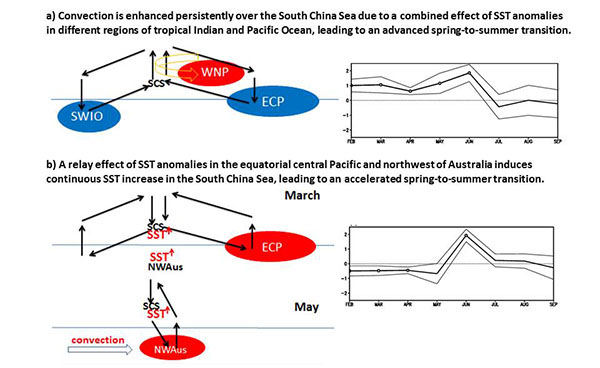State Key Laboratory of Numerical Modeling for Atmospheric Sciences and
Geophysical Fluid Dynamics (LASG)
Institute of Atmospheric Physics, Chinese Academy of Sciences

Vol. 5/No.5 April 2018
[Climate Dynamics]Two distinctive processes for abnormal spring to summer transition over the South China Sea
Highlights:Abnormal spring to summer transition over the South China Sea may occur due to two different processes. One is related to persisting anomalous convection and lower-level wind over the South China Sea induced by larger-scale sea surface temperature (SST) anomalies in the tropical Indo-Pacific region. The other is related to evolving anomalous convection and circulation in association with regional air-sea interactions around the Maritime Continent.
Summary: The period from April to June signifies the transition from spring to summer over the South China Sea and the adjacent regions. An advanced or a delayed transition has important implications for weather and climate anomaly around the South China Sea. The advanced or delayed start of summer season may be attributed to two types of anomalies. One is the persistent anomaly from spring to early summer. The other is the change of anomaly in the transition season.
Recently, Prof. WU Renguang and Dr. HE Zhuoqiseparated persistent and evolving anomalies and investigated in detail the processes leading to abnormal spring to summer transition in the South China Sea associated with these two types of anomalies. It is revealed that the persistent convection and wind anomalies over the South China Sea are related to large-scale SST anomalies in the tropical Indo-Pacific region. During spring of the La Niña decaying years, negative SST anomalies in the equatorial central Pacific (ECP) and the southwestern tropical Indian Ocean (TIO) coexist with positive SST anomalies in the tropical western North Pacific. Negative ECP SST anomalies force an anomalous Walker circulation, negative southwestern TIO SST anomalies induce anomalous cross-equatorial flows from there, and positive tropical western North Pacific SST anomalies produce a Rossby wave type response to the west (Fig.1a). Together, they contribute to enhanced convection and anomalous lower-level cyclone over the SCS, leading to an advanced transition to summer there. It is shown that the evolving convection and wind anomalies over the South China Sea involve regional air-sea interactions around the Maritime Continent. Preceding positive ECP SST anomalies induce anomalous descent around the Maritime Continent, leading to SST increase in the SCS and southeast TIO (Fig.1b). An enhanced convection region moves eastward over the south TIO during spring and reaches northwest of Australia in May (Fig.1b). This enhances descent over the SCS via an anomalous cross-equatorial overturning circulation and contributes to further warming in the SCS (Fig.1b). The SST warming in turn induces convection over the SCS, leading to an accelerated transition to summer. Analysis shows that the above two processes are equally important during 1979-2015.

Fig. 1. Schematic diagrams illustrating the two processes leading to abnormal spring-to-summer transition over the South China Sea. Red (blue) color denotes positive (negative) SST anomaly. Yellow double arrows denote Rossby wave response. Single arrow denotes anomalous overturning circulation. Gray double arrows denote the direction of movement of anomalous convection. Thick curves in the right denote composite rainfall anomalies in the South China Sea and thin curves denote the corresponding 0.5 standard deviation. WNP, ECP, SWIO, and NWAus denote western North Pacific, equatorial central Pacific, southwestern Indian Ocean, and northwest of Australia, respectively.
Citation: Wu, R., and Z. He, 2017: Two distinctive processes for abnormal spring to summer transition over the South China Sea. J. Climate, 30(23), 9665-9678, doi:10.1175/JCLI-D-17-0215.1.
Web: https://journals.ametsoc.org/doi/abs/10.1175/JCLI-D-17-0215.1
Contact: WU Renguang, renguang@mail.iap.ac.cn
E-mail: lasg_newsletter@lasg.iap.ac.cn
Editors: Chuanyi Wang (wangcy@lasg.iap.ac.cn), Kangjun Chen(ckj@lasg.iap.ac.cn)